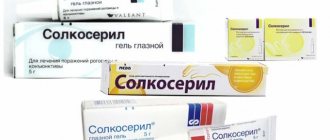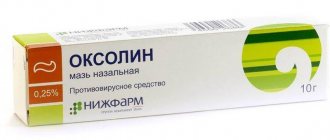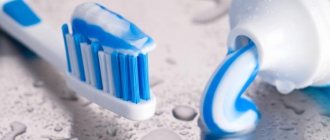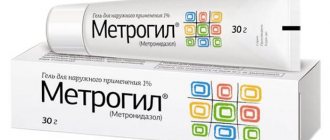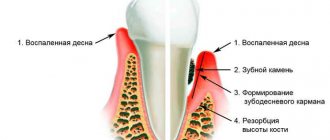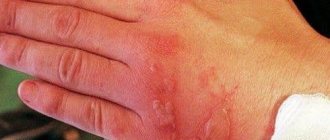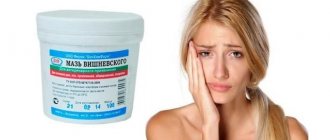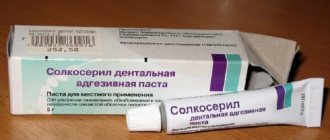To treat wide gums, special gels and ointments are used. They normalize vascular blood flow and have an epithelializing and anti-inflammatory effect. Next, you will learn about the application features, as well as the advantages of such a popular inexpensive product as Heparin ointment. It is applied directly to the gum mucosa; to enhance the effect, bandages and Diplene films can be additionally used. Pay special attention to contraindications for the use of the product, treatment of children and possible side effects.
Compound
Main active substances:
- Heparin – prevents blood clotting.
- Benzyl nicotinate is an irritant and increases circulation.
- Benzocaine is an anesthetic.
Please note that the product is not a gel, but a pharmaceutical ointment. Therefore, it would be better to apply it not to the affected gums, but to cotton swabs, then applying them to problem areas.
Heparin ointment contains a fairly high concentration of active substances - do not exceed the dosage so as not to encounter unwanted reactions.
The direct anticoagulant has a pronounced antithrombotic effect due to the gradual release of heparin. This promotes the resorption of old blood clots and prevents the formation of new ones, the synthesis of thrombins is blocked, and platelet aggregation is reduced. The activity of hyaluronidase also decreases, and the fibrinolytic characteristics of the blood are activated. Due to benzyl ester of nicotinic acid, surface vessels begin to expand, and heparin is absorbed more actively. The local anesthetic benzocaine reduces the severity of pain.
D-panthenol
This is a tissue repair stimulator, a combination drug with dexpanthenol and chlorhexidine. D-panthenol
accelerates tissue regeneration, gives an anti-inflammatory and regenerating effect.
Chlorhexidine provides antiseptic properties and an antimicrobial effect that persists even in the presence of pus, blood and other organic secretions.
D-panthenol ointment is indicated as a therapeutic and prophylactic agent in the treatment of infected wounds:
- cuts, abrasions, scratches, scratches, cracks, diaper rash, trophic ulcers and insect bites;
- deep wounds after surgery;
The drug is applied to the wound up to 3 times a day. For infants, diaper rash is treated after changing the diaper. Cracked nipples should be smeared after each feeding.
Regenerating, anti-inflammatory ointment with bactericidal, wound healing and analgesic effects. The product belongs to effective dermatotropic drugs. Contains ethylcarbitol, TEG, glycolan, glycerin. Eplan acts on all layers of the skin, kills germs, bacteria, prevents suppuration, moisturizes the skin, relieves itching, pain, accelerates healing and prevents the formation of dry scabs.
Eplan is indicated for:
- any damage to the skin: wounds, cuts, bruises, cracks, abrasions;
- burns, frostbite;
- bedsores and trophic ulcers;
- insect bites.
We suggest you familiarize yourself with Loose tonsils in children and adults: causes and treatment.
It has a cream base and is sold in 30 ml tubes. The product is applied externally twice a day until complete healing.
Properties
Heparin ointment for periodontal disease is used to relieve inflammation. More information about the causes of periodontal inflammation here. Heparin, the main active ingredient, is a direct anticoagulant that has a direct effect on the inflammatory exudative phase. The use of the drug reduces aggregation and the degree of platelet adhesion, helps to normalize microcirculation and trophic processes in tissues.
Features of the ointment, its advantages and disadvantages compared to preparations in gel form:
- High concentration of medicinal substances.
- Effective in severe stages of the disease due to good adhesion to mucous membranes.
- Vaseline softens and moisturizes the skin, but can stain clothes.
- To apply the product you need to use gauze or other additional devices.
Ointment is the only effective remedy used to treat periodontal disease.
Heparin ointment gives good results in the treatment of periodontal disease of various stages. Severe forms of the disease require a systematic approach (you also need vitamins, metabolic regulators, antibiotics, etc.).
Gum inflammation
Inflammation of the soft tissues surrounding the tooth is called gingivitis. Without adequate and timely treatment, it can lead to the development of more serious and dangerous symptoms, which can even lead to tooth loss.
Causes:
- poor oral hygiene;
- unbalanced diet, with insufficient amounts of vitamins and minerals;
- unprofessional dental treatment;
- smoking;
- prolonged mouth breathing;
- malocclusion;
- weakened immune system;
- thermal or mechanical damage to the integrity of the mucous membrane.
Gingivitis can be the underlying disease or indicate more complex pathological processes in the body.
Symptoms
You can determine if you have gum problems by the following symptoms:
- pain;
- redness;
- edema;
- contour change;
- discomfort while chewing food;
- bleeding;
- bad breath.
If you discover any of the above, you should immediately visit your dentist and begin comprehensive treatment to prevent complications from developing.
INTERESTING fact: Heparin ointment for varicose veins of the legs
For inflammation of the gums, heparin ointment is used to reduce pain, swelling and prevent the formation of exudate at the site of inflammation. The components included in the composition provide the following effect:
- heparin - slows down blood clotting,
- benzocaine - pain reliever,
- benzyl nicotinate - enhances blood circulation.
If the signs of inflammation are not treated and the unfavorable factors that led to the painful condition are not eliminated, the process will progress.
Degenerative changes may not be limited only to the mucous membrane, but also spread to deeper tissues. Such systemic damage around the dental tissues is called periodontal disease.
The exact causes of the occurrence are still unknown. The problem is considered a consequence of systemic diseases of the body, chronic processes in internal organs, and pathological changes in the bones. Hereditary predisposition also plays an important role. The occurrence is directly promoted by disturbance of local tissue circulation.
Simple ways to treat complex diseases:
Horseradish is the only plant that can draw salt through the pores of the skin. Do it - you won't regret it! Horseradish leaves will help get rid of all the salt that has accumulated in the body and can lead to painful salt deposits...Check... Read more
Never give an antibiotic BEFORE you get a blood test with a leukemia formula. Remember, write to yourself somewhere in a visible place!!! INCREASED leukocytes, ESR, lymphocytes - VIRUS. INCREASED leukocytes, ESR, segmented and rod neutrophils... Read more
What 1 glass of this drink will do to your liver can be called a real miracle! If the liver is overloaded or does not work well, we immediately feel it. Weakness, lack of energy, dizziness, nausea, pain in the right hypochondrium, problems with food... Read more
Dandelion is the elixir of life, and what a medicine!!! The medicinal dandelion is an unpretentious plant, but contains a good half of the chemical elements of the periodic table. Sodium, potassium, manganese, magnesium, and... Read more
Seeds that repair tendons and reduce joint pain. We treat osteoporosis and osteoarthritis. Osteoarthritis of the knee is a type of degenerative joint disease or arthritis that is localized in the knee and can cause pain and di... Read more
As the disease develops, sclerotic changes in bone tissue occur. Atrophic processes lead to a uniform decrease in the height of the interdental septa. An X-ray examination reveals a decrease in bone tissue and areas of osteoporosis.
Indications and contraindications
Heparin ointment is prescribed for pathology of all stages, including chronic periodontal disease. Average duration of treatment
is 10 days (but your doctor will tell you more precisely). The product is also used for thrombophlebitis of the extremities, phlebitis, thrombosis of hemorrhoidal veins, after repeated intravenous injections, and in the complex treatment of extremity ulcers.
Contraindications to therapy using heparin ointment:
- ulcerative-necrotic processes (accompanied by necrosis of nearby tissues);
- problems with blood clotting;
- thrombopenia (lack of platelets in the blood).
Self-medication is contraindicated - the drug must be prescribed to you by a doctor.
Advantages and disadvantages of local treatment
Among all drug treatments for periodontal disease, the use of topical medications is considered the most effective. Dentists highlight the following advantages of using such products:
- they are quickly absorbed by tissues, which speeds up the healing process;
- gels and ointments can be used at home;
- there are a large number of drugs, among which you can choose a remedy for the most advanced cases, pregnant women and children;
- Most topical products have a complex effect.
There are also disadvantages to this treatment:
- the course of therapy is always long, duration is from 7 to 15 days;
- It is necessary to follow the application technique, otherwise the result will be minimal;
- there is a possibility of side effects, for example, an allergic reaction or urticaria;
- with increased salivation, the applied product is quickly washed away or enters the esophagus.
After prescribing medications for the treatment of periodontal disease, the attending physician must explain how to properly apply the gel, as well as identify possible contraindications.
The choice of drug directly depends on the characteristics of the disease. There is a wide range of dental gels that have antibacterial, anti-inflammatory, healing and other effects.
Instructions: how to use for gums
Before applying the formula, brush your teeth and use a special mouthwash for periodontal disease. If there are food debris between the teeth, remove them with floss or a toothpick. Now you can apply the ointment - either with a cotton swab on the gums, or (preferably) on gauze from a tube for lotions. The layer of the medicinal product should be thin; do not exceed the dosages indicated in the instructions. Gauze strips must be sterile; to enhance the effect, it is recommended to press them to the gums using a cotton swab. If necessary, use Diplen-Dent dental film impregnated with regenerating substances.
If there are open wounds in the periodontal area, do not apply the ointment with your finger, so as not to cause additional infection.
It is enough to apply the ointment 2-3 times a day for one week (the doctor will tell you more precisely the treatment time) or until the inflammatory reactions disappear. In childhood, the product can be used, but the child should not swallow it. When teething, heparin ointment is not recommended for use - it would be better to give preference to Dentinox, Kalgel or Kamistad.
List of gels used for the treatment of periodontal disease
Gels for periodontal disease are medications that have a number of contraindications and side effects. Therefore, prescribe a medicine and a treatment regimen .
List of gels for the treatment of periodontal disease:
- Metrogil Denta.
- Kamistad.
- Asepta.
- Troxevasin.
- Holisal.
- Elugel.
- Elgifluor.
- Mundizal.
- Periodonticide.
- Levomekol.
Important! The gel texture allows the drug to be distributed softer and more evenly . In addition, this way the active ingredients are absorbed faster and are less washed off by saliva.
Metrogil Denta
Gel for gums for periodontal disease, preventive and therapeutic agent. Available freely, without a prescription. It is constantly present in pharmacies.
Active ingredients: metronidazole and chlorhexidine bigluconate. Thus, the gel is an antibiotic and has an antiseptic effect.
Metronidazole fights primarily against anaerobic bacteria that cause periodontal disease:
- Porphyromonas gingivalis.
- Prevotella intermedia.
- Fusobacterium fusiformis.
- Wolinella recta.
- Eikenella corrodens.
- Borrelia vincentii.
- Bacteroides melaninogenicus.
- Selenomonas spp.
Chlorhexidine diglucanate has long been known as an effective antiseptic. Suppresses anaerobic and aerobic bacteria:
- Treponema spp.
- Neisseria gonorrhoeae.
- Trichomonas spp.
- Chlamydia spp.
- Ureaplasma spp.
- Bactero >
Important! For this disease, Metrogyl Denta is placed by the doctor directly into the periodontal pockets.
, gums and periodontal pockets are treated with gel under the supervision of a dentist. The doctor applies a sufficient amount of the drug for the patient, so that the specified areas are covered.
Applications with the drug are made twice a day for 30 minutes for one and a half to two weeks.
Kamistad
Local anesthetic. The active ingredients are lidocaine and chamomile flower extract.
Thanks to lidocaine, pain quickly disappears as a consequence of the inflammatory process.
Chamomile has an anti-inflammatory, antimicrobial effect, and also helps regenerate the tissues of the oral mucosa.
Applied topically. A strip of product 0.5 centimeters and distributed with massaging movements onto painful areas of the oral cavity. The procedure is carried out three times a day.
Asepta
Asepta contains metronidazole, chlorhexidine and propolis extract.
The antiseptic and antimicrobial effects of metronidazole and chlorhexidine Metrogyl Denta gel , in this the drugs are the same.
However, Asepta gel also contains propolis , which has a pronounced healing effect.
In addition, additional substances in the product help relieve itching and pain.
The gel is applied in a thin layer, spreading over the entire damaged surface two to three times a day for 7-10 days.
Troxevasin
A drug containing the active ingredient troxerutin.
Photo 1. Gel Troxevasin 2%. Manufacturer BALKANFARMA-TROYAN, AD Bulgaria. Strengthens the walls of blood vessels, improves blood circulation, promotes cell regeneration.
Helps relieve swelling, capillary fragility, inflammation, and has antioxidant properties. This is a universal remedy that is used for various diseases. For periodontal disease, the gel is supposed to be applied by rubbing onto the affected area. Apply in the same way as the above products. The course of treatment lasts up to 10 days.
What can be combined with for periodontal disease?
Heparin ointment can be used to treat periodontal disease alone or in combination with other agents. Most often it is combined with antiseptics like Miramistin or Parodontocide spray, non-steroidal anti-inflammatory drugs, tissue regeneration accelerators, and multivitamins.
In advanced cases, it may be necessary to take immunostimulants or immunomodulators or antibiotics. If you have systemic diseases, your doctor may prescribe metabolic correctors and vitamins. Find out more about vitamins for periodontal disease here.
In the complex treatment of periodontal disease, it is very desirable to use herbal toothpastes like “Ranolika”, “Lesnaya”, etc.
Local treatment may additionally include rinsing with herbal decoctions (oak bark, St. John's wort), herbal anti-inflammatory drugs (nettle, yarrow); peroxide can be used for periodontal disease as prescribed by a doctor. Do not rinse after applying the ointment - first you need to rinse your mouth and only after half an hour or an hour apply the product with heparin. The drug should not be used in combination with tetracyclines and histamine H1 receptor blockers.
Read this before you start treatment
You can use any gels, creams or ointments for periodontal disease only with the permission of your doctor. The specialist will be able to determine the degree of depletion of soft periodontal tissues and select a drug suitable for a specific diagnosis.
All drugs have a common limitation - hypersensitivity to the components of which they consist. In addition, medications have individual contraindications and side effects.
Independent use of topical medications can lead to an acceleration of the development of periodontal disease.
Side effects
The drug practically does not enter the systemic circulation, so the risk of adverse reactions is minimal. In general, allergic reactions (itching, swelling, rash, allergic stomatitis), irritation (beauty, swelling of the mucous membranes) are possible. Use caution during treatment if you have a history of allergies to topical antibacterial dental medications.
To minimize the risk of unwanted reactions, use the ointment strictly according to the instructions, do not swallow, do not exceed or reduce the dosage. If strange effects occur, stop using the drug immediately and consult a doctor.
What does ointment do for periodontal disease?
With periodontal disease, it is important to improve the nutrition of the gums, which means improving blood circulation in the soft tissues. Therefore, first of all, a gel or ointment for gums should act on blood vessels and stimulate blood flow. Thus, the structure of loose gums will be restored; with regular use of the gel, they will become dense again, regain their healthy color and ability to quickly regenerate.
Another painful symptom of periodontal disease is sore and swollen gums. In severe cases, the patient simply refuses to eat, since any contact of the gums with food or drinks causes suffering. The next requirement for the drug is that the gel must have an analgesic effect.
It is not enough to relieve symptoms; it is important to eliminate their cause, namely pathogenic microorganisms as causative agents of the disease. A gel for treating gums with periodontal disease should also be antimicrobial. If the bacteria are destroyed, the inflammatory process will stop.
After eliminating the cause of the pathology, it is necessary to restore the gums, therefore it is also required that the drug has wound-healing properties and contributes to the rapid restoration of the epithelium.
And, of course, I would like the ointment or gel to have a pleasant taste and smell, be convenient and easy to use, have a minimum of side effects, combine well with other medications and be inexpensive. It seems that all these properties and qualities cannot be combined in one drug.
But modern pharmaceuticals have found the optimal formula and technology that makes it possible to create just such a gel for gums affected by periodontal disease - affordable, effective, reliable and safe.
Analogs
Popular analogues of heparin ointment:
- Cholisal is a gum gel prescribed for the treatment of stomatitis, periodontitis, gingivitis, and periodontal disease. The main active ingredients are cetolkonium chloride, choline salicylate;
- Metrogyl Denta is a broad-spectrum gel, an effective remedy for bleeding. Improves microcirculation processes, relieves swelling. The main active ingredients are metronidazole. Used for gingivitis, stomatitis, periodontal disease, alveolitis of the socket;
- Solcoseryl is a medicinal dental paste, the main component of which is a substance obtained from calf blood. It forms a thin film on the gums, which accelerates cell regeneration. Indications: stomatitis, gingivitis, wounds, ulcers. Polidocanol has an analgesic effect;
- Asepta is an antiseptic gel that specifically targets fungi and pathogenic microflora. It contains chlorhexidine and metronidazole.
It is not recommended to replace dental ointments on your own - treatment is prescribed by a doctor.
Solcoseryl gel
Solcoseryl gel is used as a stimulator of the restoration process in tissues and to normalize metabolism.
It normalizes anaerobic oxygen metabolism, increases collagen synthesis, increases fibroblast production, creates an energy reserve in cell mitochondria and maintains oxygen supply to cells.
Photo 2. A popular remedy for healing gums, Solcoseryl, is also available in the form of an ointment.
The gel contains dialysate made from the blood of young dairy calves, which allows the drug to actively activate cellular metabolism. The gel is used for erosions and ulcers in the oral cavity, for postoperative wounds and for bedsores under dentures.
Important! During the healing period of the hole, the following symptoms may appear: pain radiating to adjacent tissues; short-term bleeding; swelling and redness of the gums; short-term dysfunction of the jaw and impairment of its functionality; hypothermia (up to 38 degrees).
Solcoseryl is applied locally or on a medicinal bandage, which creates a protective layer on the affected mucous membrane of the oral cavity. The wound must be pre-treated with an antiseptic and the mouth rinsed. The gel is applied 2-3 times a day (after meals and at night).
Causes of periodontal disease
Periodontal disease is a very dangerous disease that damages the periodontal tissue. During illness, dental cells slowly atrophy, which can lead to tooth loss. This disease is very difficult to diagnose in the early stages. It appears due to a variety of chronic diseases or may arise from a hereditary predisposition.
There are many factors that influence the occurrence of periodontal disease. Most often it occurs in people with diabetes and gastrointestinal problems. The disease can also occur due to insufficient blood supply to the gums.
The causes of periodontal disease have not been fully identified
Periodontal disease can appear in those people who have tartar and overuse chewing. And also the disease can occur due to a lack of vitamin C and P in the body, which are found in fruits and vegetables. For some, the disease can be transmitted genetically. Such people especially need to monitor their oral health.
The main stages of periodontal disease
Periodontal disease is a disease that develops very slowly and has certain stages. Before starting treatment, the doctor determines exactly what it is, because it depends on whether it is possible to save the teeth or not.
Periodontal diseases - periodontitis, gingivitis, periodontal disease
Dentists have identified three main stages of periodontal disease:
- First stage. During this period, no symptoms appear. All that happens at this stage are changes in the periodontal tissue. But it is worth noting that the process occurs without any pain.
- Second phase. During this period, symptoms such as: with oral hygiene, the gums begin to bleed, and in the process of eating food, it begins to get stuck between the teeth.
- Third stage. This is the last stage of the disease, which is the most severe and dangerous. During this period, irreversible processes occur that destroy the periodontal tissue. It is at this stage that a person may be left without teeth.
Read also: Pain-relieving ointment for teeth
Before making a diagnosis and determining the degree of the disease, the doctor examines the oral cavity and the size of the septum. Only after this is individual therapy prescribed, which occurs in several stages.
Selection of treatment
It is important to note that the treatment of periodontal disease is carried out in a complex manner. In order to eliminate the disease, the doctor can prescribe a variety of drugs for periodontal disease, which give good results only when used together. These can be tablets, ointments or special solutions for rinsing the mouth. First of all, the doctor must improve the patient’s immunity. The thing is that if the patient has any diseases, then they need to be treated, since periodontal disease is accompanied by a decrease in immunity.
This suggests that the treatment of the disease goes beyond the scope of the dental office. It is worth noting that each medicine for periodontal disease has a number of advantages, disadvantages and contraindications. Particular attention should be paid to ointments and gels for periodontal disease. In general, treatment of periodontal disease with ointment will not be effective if this remedy is used without auxiliary medications. Ointment is a fat-based product, and this is its disadvantage, since it will not be able to properly adhere to the applied area. This can lead to a reduction in the period of exposure to the problem area. The ointment does not penetrate the gums well. Gels are the most effective remedy.
In their composition and active substances, they are similar to ointment, but have a consistency more convenient for the oral cavity. The gel can adhere well to the oral mucosa and quickly penetrates into the painful area. Since the gel adheres well to the gums, its effect is longer than that of the ointment. The exposure time increases, which is another advantage of the gel.
